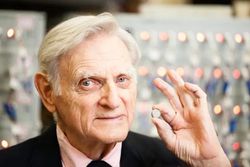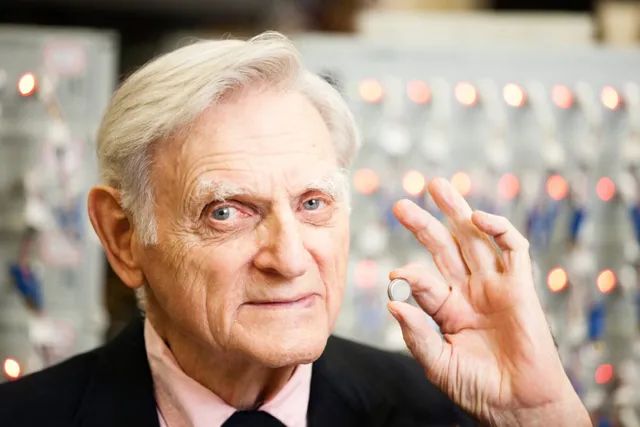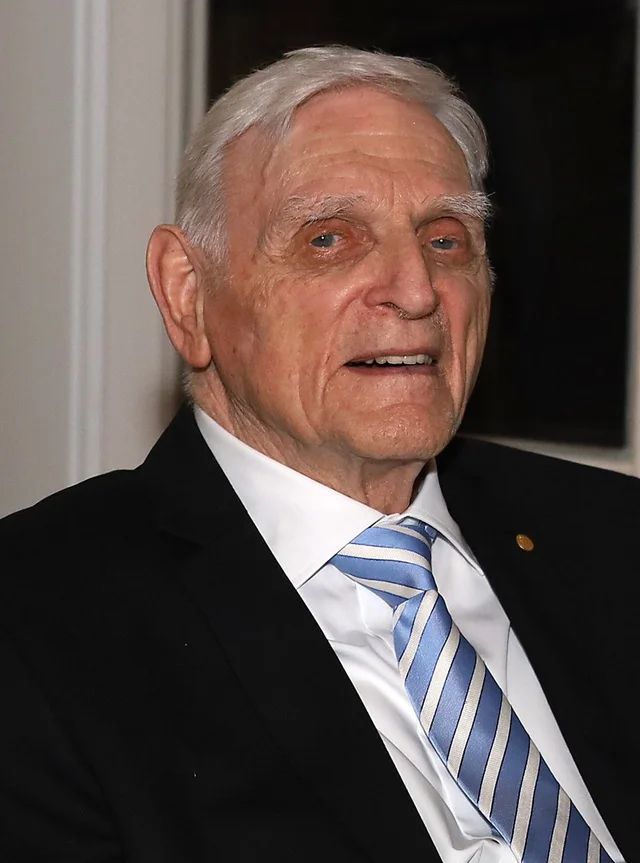Goodenough was born in Jena, Germany, to American parents. During and after graduating from Yale University, Goodenough served as a U.S. military meteorologist in World War II. He went on to obtain his Ph.D. in physics at the University of Chicago, became a researcher at MIT Lincoln Laboratory, and later the head of the Inorganic Chemistry Laboratory at the University of Oxford. From 1986 on he was a professor in the school of engineering at UT Austin.
Goodenough was awarded the National Medal of Science, the Copley Medal, the Fermi Award, the Draper Prize, and the Japan Prize. The John B Goodenough Award in materials science is named for him. In 2019, he was awarded the Nobel Prize in Chemistry alongside M. Stanley Whittingham and Akira Yoshino, and, at 97 years old, became the oldest Nobel laureate in history. From August 27, 2021, until his death, he was the oldest living Nobel Prize laureate.∼Nobel Laureate Scientist. He was best known for sharing the 2019 Nobel Prize for Chemistry with fellow scientists M. Stanley Whittingham and Yoshino Akira. They were honored for their work in the development of lithium-ion batteries. He received a bachelor's degree in mathematics from Yale University in 1943, while serving in the United States Army Air Forces as a meteorologist. After the end of World War II, he did his graduate studies in physics at the University of Chicago, where he earned a master's in 1951 and a doctorate a year later. That same year, he became a research scientist at the Lincoln Laboratory at the Massachusetts Institute of Technology. There, one of his first projects was developing the SAGE air defense computer's memory cores, which were the first random access memory (RAM). He became a professor at the University of Oxford in 1976 and head of the Inorganic Chemistry Laboratory. That same year, M. Stanley Whittingham had developed the first lithium-ion battery with an anode of metallic lithium and a cathode of lithium ions in between layers of titanium disulfide. He knew the battery would have a higher voltage if the cathode was a metal oxide rather than a metal sulfide. In 1979, he and his collaborators developed a battery with a cathode of lithium ions between layers of cobalt oxide. This battery had a potential of 4 volts, while the Whittingham battery had a potential of only 2.5 volts. He later became a professor at the University of Texas at Austin in 1986 in the departments of mechanical engineering and electrical and computer engineering. He was honored with numerous awards during his career, including sharing the 2019 Nobel Prize for Chemistry with Whittingham and Yoshino Akira. He also wrote several books during his career.
Goodenough was born in Jena, Germany, to American parents. During and after graduating from Yale University, Goodenough served as a U.S. military meteorologist in World War II. He went on to obtain his Ph.D. in physics at the University of Chicago, became a researcher at MIT Lincoln Laboratory, and later the head of the Inorganic Chemistry Laboratory at the University of Oxford. From 1986 on he was a professor in the school of engineering at UT Austin.
Goodenough was awarded the National Medal of Science, the Copley Medal, the Fermi Award, the Draper Prize, and the Japan Prize. The John B Goodenough Award in materials science is named for him. In 2019, he was awarded the Nobel Prize in Chemistry alongside M. Stanley Whittingham and Akira Yoshino, and, at 97 years old, became the oldest Nobel laureate in history. From August 27, 2021, until his death, he was the oldest living Nobel Prize laureate.∼Nobel Laureate Scientist. He was best known for sharing the 2019 Nobel Prize for Chemistry with fellow scientists M. Stanley Whittingham and Yoshino Akira. They were honored for their work in the development of lithium-ion batteries. He received a bachelor's degree in mathematics from Yale University in 1943, while serving in the United States Army Air Forces as a meteorologist. After the end of World War II, he did his graduate studies in physics at the University of Chicago, where he earned a master's in 1951 and a doctorate a year later. That same year, he became a research scientist at the Lincoln Laboratory at the Massachusetts Institute of Technology. There, one of his first projects was developing the SAGE air defense computer's memory cores, which were the first random access memory (RAM). He became a professor at the University of Oxford in 1976 and head of the Inorganic Chemistry Laboratory. That same year, M. Stanley Whittingham had developed the first lithium-ion battery with an anode of metallic lithium and a cathode of lithium ions in between layers of titanium disulfide. He knew the battery would have a higher voltage if the cathode was a metal oxide rather than a metal sulfide. In 1979, he and his collaborators developed a battery with a cathode of lithium ions between layers of cobalt oxide. This battery had a potential of 4 volts, while the Whittingham battery had a potential of only 2.5 volts. He later became a professor at the University of Texas at Austin in 1986 in the departments of mechanical engineering and electrical and computer engineering. He was honored with numerous awards during his career, including sharing the 2019 Nobel Prize for Chemistry with Whittingham and Yoshino Akira. He also wrote several books during his career.
Family Members
Sponsored by Ancestry
Advertisement
Explore more
Sponsored by Ancestry
Advertisement






